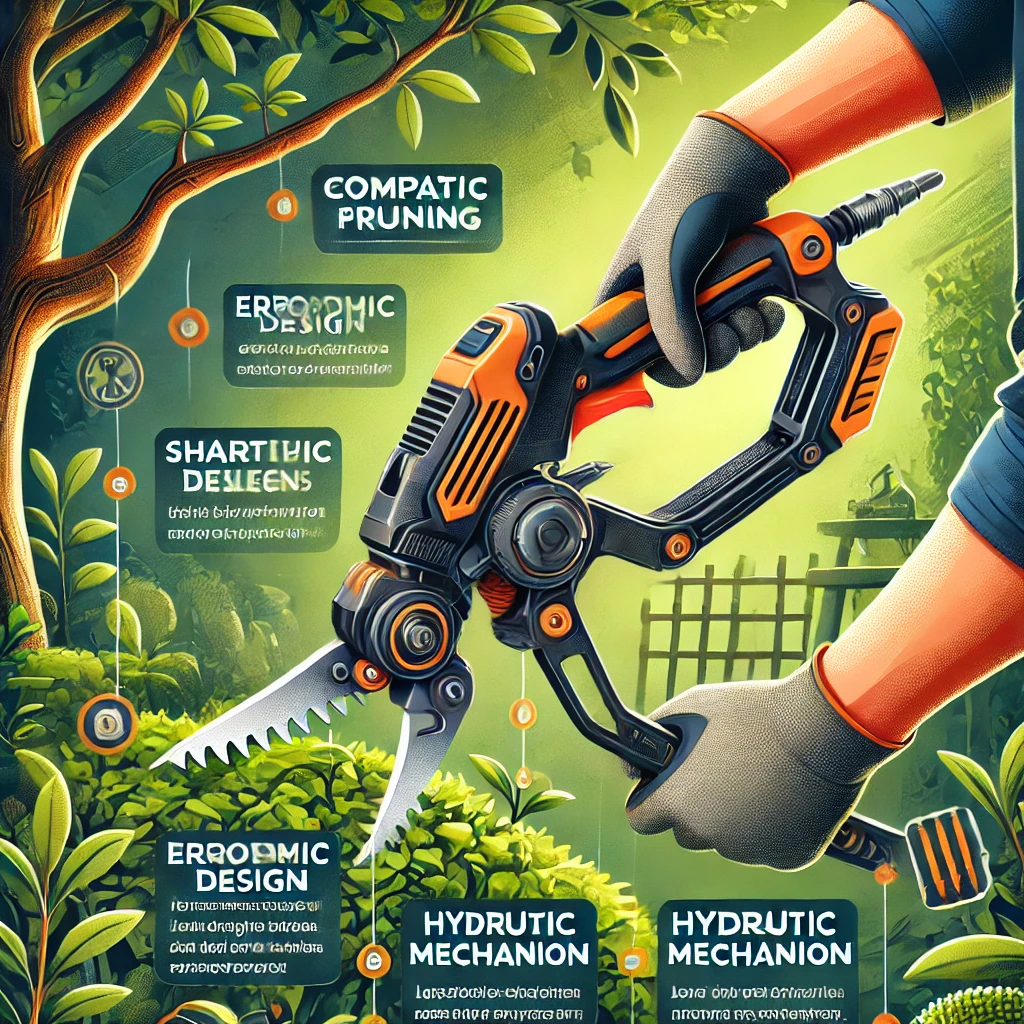When it comes to efficient and powerful tools for trimming hard-to-reach branches, hydraulic motor pole saws stand out as a reliable choice. If you’re considering investing in one, this comprehensive guide will provide you with all the essential details, from how they work to their advantages, disadvantages, and frequently asked questions.
Table of Contents
What Is a Hydraulic Motor Pole Saw?
A hydraulic motor pole saw is a specialized cutting tool powered by hydraulic pressure. Unlike electric or gas-powered pole saws, hydraulic pole saws use a hydraulic system to deliver power to the saw head. These tools are often preferred for heavy-duty applications, such as professional landscaping, arborist work, and forestry operations.
How Does a Hydraulic Motor Pole Saw Work?
The hydraulic motor pole saw operates using a hydraulic system that generates power through fluid pressure. Here’s how it works:
- Hydraulic Pump: The system’s pump pressurizes hydraulic fluid.
- Motor Drive: This pressure drives the motor connected to the saw blade.
- Cutting Action: The blade moves efficiently to cut through thick branches and limbs.
This design makes hydraulic pole saws powerful, precise, and efficient for demanding tasks.
Pros
Cons
Key Features to Look for in Hydraulic Motor Pole Saws
When choosing a hydraulic motor pole saw, consider the following features to ensure it meets your needs:
- Pole Length: Choose a length that allows you to reach high branches safely.
- Cutting Capacity: Ensure the saw can handle the branch diameters you typically deal with.
- Build Quality: Opt for durable materials like high-grade aluminum or fiberglass for the pole.
- Hydraulic Pressure Rating: Match the saw’s pressure requirements with your hydraulic system.
- Portability: Look for a design that is lightweight and easy to maneuver.
- Safety Features: Features like anti-slip grips and safety locks are crucial for safe operation.
Who Should Use a Hydraulic Motor Pole Saw?

- Professional Arborists: For tasks requiring robust and reliable cutting performance.
- Landscapers: Ideal for trimming and maintaining trees in large properties.
- Forestry Workers: Perfect for heavy-duty and prolonged usage in forest environments.
- Farmers: Useful for maintaining orchards and other agricultural trees.
If you’re a homeowner with basic trimming needs, a hydraulic motor pole saw might be overkill. Consider electric or gas-powered options for lighter tasks.
Tips for Using a Hydraulic Motor Pole Saw Safely
- Wear Protective Gear: Always wear gloves, safety glasses, and a helmet.
- Inspect Before Use: Check the hydraulic lines, motor, and blade for any damage.
- Maintain Stability: Use a firm stance and avoid overreaching while cutting.
- Be Mindful of Overhead Power Lines: Ensure there’s no risk of contact with electrical lines.
- Follow Manufacturer Instructions: Adhere to all guidelines for setup and operation.
Choosing the Best Compact Hydraulic Pruning Tool for Your Needs
Pruning tools are essential for maintaining trees, shrubs, and plants, and hydraulic pruning tools are gaining popularity for their power and efficiency. When choosing the best compact hydraulic pruning tool, understanding its features, pros, cons, and applications is crucial. This guide will help you select the right tool tailored to your specific needs.
You may also like
What Is a Compact Hydraulic Pruning Tool?
A compact hydraulic pruning tool is a cutting device powered by hydraulic systems, designed for precision and efficiency in pruning tasks. Unlike manual or electric pruning tools, hydraulic models use pressurized fluid to deliver power, allowing for effortless cuts on thicker branches and dense vegetation.
How Does a Compact Hydraulic Pruning Tool Work?
Hydraulic pruning tools rely on a simple yet effective mechanism:
- Hydraulic Pressure: A pump pressurizes hydraulic fluid, which powers the tool’s blade.
- Cutting Mechanism: The blade exerts significant force on the branch, ensuring a clean cut.
- Compact Design: The smaller size allows for easy handling and maneuverability in tight spaces.
This combination of power and portability makes compact hydraulic pruning tools ideal for professional landscapers and demanding pruning tasks.
Key Features to Consider When Choosing a Compact Hydraulic Pruning Tool

- Cutting Capacity: Ensure the tool can handle the branch diameters you typically prune.
- Weight and Ergonomics: A lightweight and well-balanced tool reduces fatigue during prolonged use.
- Hydraulic Pressure Requirements: Match the tool’s pressure needs with your existing hydraulic system.
- Blade Material: Look for high-carbon steel or other durable materials for long-lasting performance.
- Portability: Compact models should be easy to transport and operate.
- Safety Features: Anti-slip grips, blade covers, and safety locks are essential.
Top Applications for Compact Hydraulic Pruning Tools
- Arboriculture: Perfect for trimming trees and removing dead or overgrown branches.
- Horticulture: Ideal for shaping and maintaining plants in gardens or greenhouses.
- Vineyard Management: A go-to tool for pruning grapevines efficiently.
- Orchard Care: Helps in maintaining fruit trees for optimal growth and productivity.
Tips for Choosing the Best Compact Hydraulic Pruning Tool
- Define Your Needs: Identify the type of pruning you’ll be doing most often.
- Evaluate Compatibility: Ensure the tool works with your existing hydraulic setup.
- Test for Comfort: Opt for ergonomic designs to enhance ease of use.
- Research Brands: Trusted brands often offer better reliability and support.
- Consider Accessories: Look for additional features like interchangeable blades and carrying cases.
FAQs
1. Are hydraulic motor pole saws better than gas or electric saws?
Hydraulic saws are superior for heavy-duty tasks due to their power and durability. However, for light to medium jobs, gas or electric models may be more practical and portable.
2. Do I need a special hydraulic system to operate a hydraulic pole saw?
Yes, a compatible hydraulic power source is required to run the saw effectively. This could be a dedicated hydraulic pump or a connection to existing hydraulic machinery.
3. How much does a hydraulic motor pole saw cost?
Prices range from $500 to over $1,500, depending on the brand, features, and size. Professional-grade models are on the higher end of the spectrum.
4. Can I use a hydraulic motor pole saw in wet conditions?
While hydraulic systems are less affected by water than electric systems, always follow the manufacturer’s guidelines for safe use in wet conditions.
5. How do I maintain a motor pole saw?
Regularly check and replace hydraulic fluid, inspect hoses for leaks, and clean the blade after each use to maintain performance.
Conclusion
A hydraulic motor pole saw is a powerhouse tool for professional landscapers, arborists, and forestry workers. While the upfront investment is higher, its durability, performance, and efficiency make it worthwhile for demanding tasks. By understanding the features, pros, cons, and proper usage, you can ensure that you make an informed purchase.
If you’re considering a hydraulic motor pole saw, weigh your specific needs against the capabilities of these powerful tools. With the right choice, you’ll have a reliable companion for all your tree-trimming and landscaping projects.



Leave a Reply